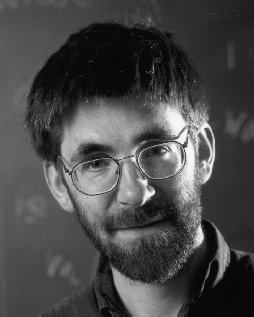 |
Richard
Ewen Borcherds
(born 29 November 1959)
He has been "Royal Society Research Professor" at the Department
of Pure Mathematics and Mathematical Statistics at Cambridge University
since 1996. Borcherds began his academic career at Trinity College,
Cambridge before going as assistant professor to the University
of California in Berkeley. He has been made a Fellow of the Royal
Society, and has also held a professorship at Berkeley since 1993.
|
| |
| Richard
E. Borcherds will receive a medal for his work in the fields
of algebra and geometry, in particular for his proof of the so-called
Moonshine conjecture. This conjecture was formulated at the end
of '70s by the British mathematicians John Conway and Simon Norton
and presents two mathematical structures in such an unexpected relationship
that the experts gave it the name "Moonshine". In 1989, Borcherds
was able to cast some more light on the mathematical background
of this topic and to produce a proof for the conjecture. The Moonshine
conjecture provides an interrelationship between the so-called "monster-groups"
and elliptical functions. These functions are used in the construction
of wire-frame structures in two-dimensions, and can be helpful,
for example, in chemistry for the description of molecular structures.
Monster groups, in contrast, only seemed to be of importance in
pure mathematicians. Groups are mathematical objects which can be
used to describe the symmetry of structures. Expressed technically,
they are a set of objects for which certain arithmetic rules apply
(for example all whole numbers and their sums form a group). An
important theorem of algebra says that all groups, however large
and complicated they may seem, all consist of the same components
- in the same way as the material world is made up of atomic particles.
The "monster group" is the largest "sporadic, finite, simple" group
- and one of the most bizarre objects in algebra. It has more elements
than there are elementary particles in the universe (approx. 8 x
10^53). Hence the name "monster". In his proof, Borcherds uses many
ideas of string theory - a surprisingly fruitful way a making theoretical
physics useful for mathematical theory. Although still the subject
of dispute among physicists, strings offer a way of explaining many
of the puzzles surrounding the origins of the universe. They were
proposed in the search for a single consistent theory which brings
together various partial theories of cosmology. Strings have a length
but no other dimension and may be open strings or closed loops.
|
|
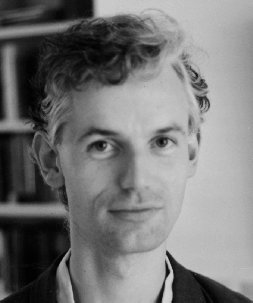 |
William
Timothy Gowers
(born 20 November 1963)
He is lecturer at the Department of Pure Mathematics and Mathematical
Statistics at Cambridge University and Fellow of Trinity College.
From October 1998 he will be Rouse Professor of Mathematics. After
studying through to doctorate level at Cambridge, Gowers went
to University College London in 1991, staying until the end of
1995. In 1996 he received the Prize of the European Mathematical
Society.
|
| |
| William
Timothy Gowers has provided important contributions to functional
analysis, making extensive use of methods from combination theory.
These two fields apparently have little to do with each other, and
a significant achievement of Gowers has been to combine these fruitfully.
Functional analysis and combination analysis have in common that
many of their problems are relatively easy to formulate, but extremely
difficult to solve. Gowers has been able to utilise complicated
mathematical constructions to prove some of the conjectures of the
Polish mathematician Stefan Banach (1892-1945), including the problem
of "unconditional bases". Banach was an eccentric, preferring to
spend his time in the caf¨¦ rather than in his office in the University
of Lvov. In the twenties and thirties he filled a notebook with
problems of functional analysis while sitting in the "Scottish Caf¨¦",
so that this later became known as the Scottish Book. Gower has
made significant contribution above all to the theory of Banach
spaces. Banach spaces are sets whose members are not numbers but
complicated mathematical objects such as functions or operators.
However, in a Banach space it is possible to manipulate these objects
like numbers. This finds applications, for example, in quantum physics.
A key question for mathematicians and physicists concerns the inner
structure of these spaces, and what symmetry they show. Gowers has
been able to construct a Banach space which has almost no symmetry.
This construction has since served as a suitable counter-example
for many conjectures in functional analysis, including the hyperplane
problem and the Schr?der-Bernstein problem for Banach spaces. Gowers'
contribution also opened the way to the solution of one of the most
famous problems in functional analysis, the so-called "homogeneous
space problem". A year ago, Gowers attracted attention in the field
of combination analysis when he delivered a new proof for a theorem
of the mathematician Emre Szemeredi which is shorter and more elegant
than the original line of argument. Such a feat requires extremely
deep mathematical understanding. |
|
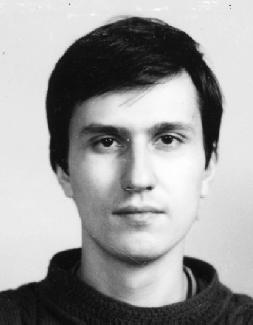 |
Maxim Kontsevich
(born 25 August 1964)
He is a professor at the Institute des Hautes Etudes Scientific
(I.H.E.S) in France and visiting professor at the Rutgers University
in New Brunswick (USA). After studying at the Moscow University
and beginning research at the "Institute for Problems of Information
Processing", he gained a doctorate at the University of Bonn,
Germany in 1992. He then received invitations to Harvard, Princeton,
Berkeley and Bonn.
|
| |
| Maxim
Kontsevich has established a reputation in pure mathematics
and theoretical physics, with influential ideas and deep insights.
He has been influenced by the work of Richard Feynmann and Edward
Witten. Kontsevich is an expert in the so-called "string theory"
and quantum field theory. He made his name with contributions to
four problems of geometry. He was able to prove a conjecture of
Witten and demonstrate the mathematical equivalence of two models
of so-called quantum gravitation. The quantum theory of gravity
is an intermediate step towards a complete unified theory. It harmonises
physical theories of the macrocosm (mass attraction) and the microcosm
(forces between elementary particles). Another result of Kontsevich
relates to knot theory. Knots mean exactly the same thing for mathematicians
as for everyone else, except that the two ends of the rope are always
jointed together. A key question in knot theory is, which of the
various knots are equivalent? Or in other words, which knots can
be twisted and turned to produce another knot without the use of
scissors? This question was raised at the beginning of the 20th
century, but it is still unanswered. It is not even clear which
knots can be undone, that is converted to a simple loop. Mathematicians
are looking for ways of classifying all knots. They would be assigned
a number or function, with equivalent knots having the same number.
Knots which are not equivalent must have different numbers. However,
such a characterisation of knots has not yet been achieved. Kontsevich
has found the best "knot invariant" so far. Although knot theory
is part of pure mathematics, there seem to be scientific applications.
Knot structures occur in cosmology, statistical mechanics and genetics.
|
|
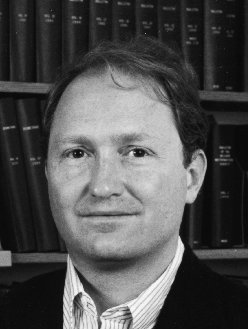 |
Curtis T.
McMullen
(born 21 May 1958)
He is visiting professor at Harvard University. He studied in
Williamstown, Cambridge University and Paris before gaining a
doctorate in 1985 at Harvard. He lectured at various universities
before becoming professor at the University of California in Berkeley.
Since 1998 he has taught at Harvard. The Fields Medal is his tenth
major award. In 1998 he has been elected to the American Academy
of Arts and Sciences.
|
| |
| Curtis
T. McMullen is being awarded a medal primarily in recognition
of his work in the fields of geometry and "complex dynamics", a
branch of the theory of dynamic systems, better known perhaps as
chaos theory. McMullen has made contributions in numerous fields
of mathematics and fringe areas. He already provided one important
result in his doctoral thesis. The question was how to calculate
all the solutions of an arbitrary equation. For simple equations
it is possible to obtain the solutions by simple rearrangement.
For most equations, however it is necessary to use approximation.
One well-known form is the "Newton method" - already known in a
rudimentary form in ancient times. For second-degree polynomials
this provides very good results without exception. A key question
therefore was whether a comparable method - which happened not to
have been discovered - also existed for equations of higher degrees.
Curtis T. McCullen's conclusion was that there is definitely no
such universal algorithm for equations above degree three; only
a partially applicable method is possible. For degree-three equations
he developed a "new" Newtonian method and could thus completely
solve the question of approximation solutions. A further result
of McMullen relates to the Mandelbrot set. This set describes dynamic
systems which can be used to model complicated natural phenomena
such as weather or fluid flow. The point of interest is where a
system drifts apart and which points move towards centres of equilibrium.
The border between these two extremes is the so-called Julia set,
named after the French mathematician Gaston Julia, who laid the
foundations for the theory of dynamic systems early in the twentieth
century. The Mandelbrot set shows the parameters for which the Julia
set is connected, i.e. is mathematically attractive. This description
is very crude, but a better characterisation of the boundary set
was not available. Curtis T. McMullen made a major advance, however,
when he showed that it is possible to decide in part on the basis
of the Mandelbrot set which associated dynamic system is "hyperbolic"
and can therefore be described in more detail. For these systems
a well-developed theory is available. McMullen's results were suspected
already in the sixties, but nobody had previously been able to prove
this exact characterisation of the Julia set. |
| |
| Andrew
J. Wiles awarded the "IMU silver plaque" |
| |
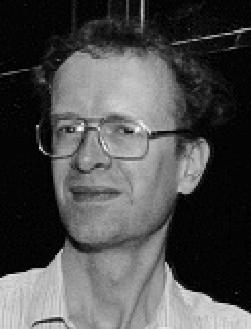 |
Andrew J.
Wiles
(born 11 April 1953)
He is Professor of Mathematics at Princeton University. Since
1995 he has also been a member of the Institute for Advanced Study
(IAS). Wiles studied in England at Cambridge University before
going to America as assistant professor at Harvard in 1974. In
1982 he became professor in Princeton. His fields of research
are number theory and arithmetic geometry.
|
| |
| The British mathematician Andrew
J. Wiles has been honoured with the "IMU silver plaque" at
18 August. The chairman of the Fields Medals Committee, Yuri Manin,
presented him with this award during the opening ceremony of the
International Congress of Mathematicians
in the Berlin International Congress Centre. This world congress
of mathematicians, the largest and most important one worldwide,
is taking place until 25th August. Some 3500 mathematicians from
all over the world will be visiting Berlin to participate. During
the congress, which is held every four years, four Fields Medals
are awarded to outstanding mathematicians under the age of forty.
In view of their significance the Fields Medals are often dubbed
the "Nobel Prize of mathematics". Four years ago, Andrew J. Wiles
was a hot favourite for an award, since in 1993 he had presented
a proof of Fermat's Last Theorem - one of the most famous mathematical
puzzles, which had remained unsolved for more than 350 years. Shortly
afterwards, however, colleagues found a gap in the proof which Wiles
was only able to close up a year later. But this was too late for
the Fields Medal, because Wiles was then over the age limit of forty.
With its special tribute, the International
Mathematics Union (IMU) wishes to acknowledge Andrew Wiles'
outstanding achievement. |
| |
|
|
This document has been reproduced from
The Website of International Congress of
Mathematicians, Berlin 1998.
Albers, Donald J.; Alexanderson, G. L.;
Reid, Constance:
International mathematical congresses. An illustrated history
1893 - 1986
Rev. ed. including ICM 1986. Springer-Verlag, New York, 1986
with friendly permission from Springer
Verlag
|
|